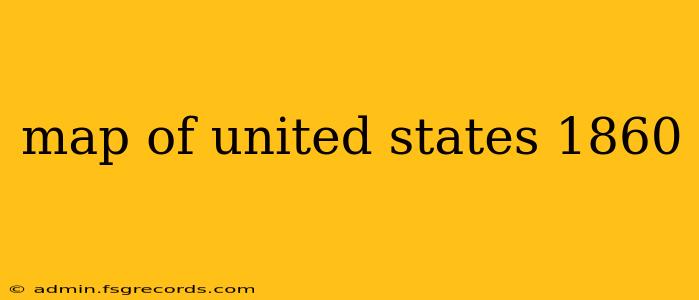The year 1860 stands as a pivotal moment in American history, a precipice on the brink of the Civil War. Examining a map of the United States from that year offers a fascinating glimpse into the geographical and political divisions that would soon erupt into conflict. More than just a geographical representation, an 1860 map reveals the complex tapestry of slavery, economic disparity, and sectionalism that defined the nation.
Understanding the Geographic Divisions of 1860
A detailed map of the United States in 1860 would immediately highlight the stark contrast between the North and the South. The Mason-Dixon Line, while not a precise legal boundary, serves as a powerful visual representation of the dividing line between free and slave states. States north of this line, generally, were free states, while those to the south, with a few exceptions, were slave states. This geographical division wasn't simply a matter of latitude; it reflected deep-seated differences in economic systems, social structures, and political ideologies.
The Free States: Industry and Abolitionism
The northern states, largely industrialized, were characterized by burgeoning cities, growing manufacturing sectors, and a rising abolitionist movement. Cities like Boston, New York, and Philadelphia were centers of commerce and intellectual ferment, driving the demand for reform and challenging the institution of slavery. On a map, you'd see the concentration of population and industrial centers in the Northeast, a stark contrast to the predominantly agrarian South.
The Slave States: Agriculture and the "Peculiar Institution"
The southern states, heavily reliant on agriculture, particularly cotton production, depended on enslaved labor. This "peculiar institution," as it was often called, shaped the entire social and economic fabric of the South. Large plantations dominated the landscape, and the concentration of enslaved people was directly correlated with the economic prosperity of the region. A map would visually demonstrate the concentration of cotton production in the Deep South, highlighting the economic underpinnings of the institution of slavery and the South's reliance on it.
Beyond the Simple North-South Divide: Nuance in the 1860 Map
While the free and slave state divide is the most striking feature of an 1860 map, it's crucial to understand the nuances within each region. The border states, such as Missouri, Kentucky, Maryland, and Delaware, presented a unique challenge. These states, while allowing slavery, were geographically closer to the North and often exhibited more divided loyalties during the Civil War. These complexities would be readily apparent on a detailed map, showing the geographical proximity to both the North and the South and perhaps even hinting at the internal political struggles within these states.
Furthermore, the western territories, shown as largely unsettled on many 1860 maps, were a significant point of contention. The question of whether these territories would be admitted to the Union as free or slave states fueled the political battles of the decade leading up to the war. Observing these territories on the map allows one to visualize the expanding frontier and the battles over its future.
Utilizing Maps of 1860 for Historical Understanding
Studying maps from 1860 isn't just about pinpointing state boundaries. It's about understanding the geographical context of a pivotal moment in American history. By analyzing the distribution of population, the location of major cities, and the agricultural patterns, we can gain a richer understanding of the economic and social forces that drove the nation towards civil war. These maps provide invaluable visual aids in understanding the complex interplay of geography, politics, and social structures that shaped the United States in 1860 and its subsequent trajectory. They offer a silent but powerful testament to the divisions and the tensions that ultimately led to the bloodiest conflict in American history.

